Clinical Center News
Finding the new 'normal' after allogeneic stem cell transplantation
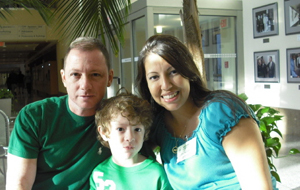 |
After undergoing treatment for chronic myelogenous leukemia, Carlos Carleo was told his chances of having a child with his wife Lilibeth were slim. Now the family, including little Carlos, travel to NIH yearly for follow-up exams and to participate in a quality-of-life research survey.
|
As any survivor knows, life doesn’t snap back to the way it was as soon as one hears that coveted "r" word—remission. Nurse researchers at the Clinical Center are leading a study to examine function, adjustment, quality of life, and symptoms (FAQS) in long-term survivors who have undergone an allogeneic (from a donor) hematopoietic (blood) stem cell transplant (HSCT).
Dr. Margaret Bevans and Dr. Sandra Mitchell of Nursing and Patient Care Services and their multi-institute study team collect survey data once a year from participants to characterize the pattern of recovery after this intense treatment regimen. Understanding the factors that influence variation in these recovery patterns can help patients know what to expect over the long term and help clinicians improve services to aid in patients’ recovery. "Together with other intramural researchers conducting survivorship studies here on campus, we are contributing to the evidence base to guide assessment and tailor interventions in transplant survivors," Mitchell said [see sidebar, bottom].
Mitchell and Bevans began their work in 2005, noting gaps in the understanding of the recovery experience for several specific groups of transplant survivors. As the researchers noted in their summary of the study, most previous research had been cross-sectional (giving a snapshot rather than a timline) and had sampled a small number of survivors with limited diversity." In the FAQS study, Bevans and Mitchell are examining the extent to which a patient’s condition improves, remains the same, or deteriorates with the passage of time after HSCT in a large sample of transplant survivors with clinical and demographic diversity.
The National Heart, Lung, and Blood Institute performed its first allogeneic HSCT in 1993 on patient Javier Egremy-Gracia, who suffered from chronic myelogenous leukemia (CML). His doctors in Mexico knew of an NIH protocol treating children with the same disease and sent a letter describing his case. Dr. A. John Barrett, chief of the NHLBI Hematology Branch Stem Cell Allogeneic Transplantation Section, performed the transplant with donor cells from Egremy-Garcia’s brother, Alfredo.
"My improvement was not immediate, but little by little, I started recovering," Egremy-Garcia said. In the 16 years since his treatment, he says he has felt mostly healthy, except for an infection, three years ago. He suffers from fatigue, peripheral nerve damage, and diabetes, but describes his health as good and is often too busy with work as a lawyer to schedule follow-up trips to NIH.
Mitchell and Bevans’ FAQS study proceeds in tandem with other intramural NIH research examining late effects of this intense, often curative treatment for cancer or a serious bone marrow disorder. These late effects may include chronic graft-versus-host disease, osteoporosis, endocrine complications, and secondary cancers.
"All typical problems seen in cancer survivors are multiplied after allogeneic HSCT. Therefore the treatment presents a unique opportunity for researchers to develop strategies to address late effects of cancer therapy," said Dr. Steven Z. Pavletic, head of the Graft-Versus-Host and Autoimmunity Unit in the National Cancer Institute Experimental Transplantation and Immunology Branch.
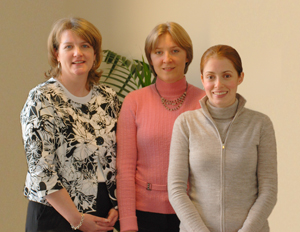 |
Contributing to the FAQS study are (from left) Kathleen (Kate) Castro, Olena Prachenko, and Eleftheria (Libby) Koklanaris. Also on the team, but not pictured, is Lisa Cook.
|
As nurse scientists, Bevans and Mitchell are particularly interested in the impact these late effects may have on how patients feel and function as they resume usual activities and roles in their daily lives.
In the early period of recovery after an allogeneic HSCT, patients and families are often focused on aspects of physical recovery from an aggressive treatment regimen. As they proceed into the survivorship phase, other dimensions of well-being including mood, relationships, and symptoms such as fatigue and impaired sleep problems come to the forefront. The opportunity to complete the study questionnaires may help to validate the importance of these issues, and "may empower survivors to be their own advocates and raise such concerns with the doctors, nurses, and social workers on their transplant team," Bevans said.
Study results to date suggest that a number of these dimensions are affected in transplant survivors. For example, the team has found that approximately 45 percent of study participants had insomnia, and that those with more physical and psychological symptom distress reported more problems with sleep. Survivors experiencing difficulties with psychosocial adjustment reported the greatest concerns with immediate and extended family issues, sexual relationships, and emotional distress. Ultimately, Bevans and Mitchell believe that a better understanding of the factors associated with variability in recovery can be applied to develop ways to help patients return to a fulfilling and productive life.
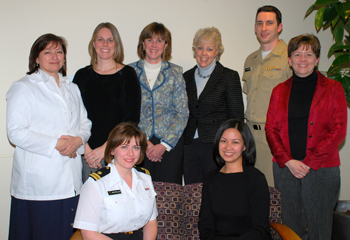 |
|
The FAQS study team, including (from left, back) Bazetta Blacklock-Schuver, Nonniekaye Shelburne, Dr. Sandra Mitchell, Patricia Prince, Michael Krumlauf, Dr. Margaret Bevans, and (front) Leslie Wehrlen and Caroline Stewart, have seen great participation from NIH HSCT survivors.
|
"The FAQS study is making major progress in this direction, but it only addresses the first step—describing the scope of the problem. The big next challenge is to decide what to do about the problem," Pavletic said. "Survivors face a number of challenges affecting their health and well-being. Much work remains to be done in this arena, and the NIH can be a major contributor."
Carlos Carleo is living a life he didn’t know was possible following his CML treatments. As his 4-year-old son played at his feet, Carleo told his tale of radiation, chemotherapy, and a HSCT in 1994 from his sister’s donor cells. Conception after cancer therapies is rare, but Carleo told doctors he would not freeze his sperm before treatment. "If God wants me to have kids, I’ll have them." Carleo and his wife, Lilibeth, call their son, Carlos’ namesake, "such a blessing."
He returns to the NIH each year for monitoring and completes the quality-of-life surveys, reporting everything is fine. "I like to see the other patients and try to lift their spirits," Carleo said. "I feel very blessed, very lucky."
Another transplant survivor, Norine Denise Birckhead had an HCST in 1994 after a diagnosis of CML. The last 15 years have been a journey, especially the debilitating loss of independence during her illness and recovery. Today, though, Birckhead is healthy and happy to participate in the follow-up protocols. "I hope they find something that can help others," she said.
Mitchell and Bevans report that patients are enthusiastic about participating in survivorship studies, saying that they feel like they are helping future transplant recipients and contributing to the mission of the NIH to develop new knowledge that improves outcomes. "The NIH dedicates itself to cases like me … the research at the NIH is the reason I survived," said Egremy-Gracia.
|
NIH intramural research on late effects of allogeneic HSCT
05-H-0130—Long-Term Evaluation and Follow-Up Care of Patients Treated with Allogeneic Transplants
05-CC-0216—Quality of Life in Allogeneic Transplant Survivors
04-C-0281—Natural History Study of Clinical and Biological Factors Determining Outcomes in Chronic GVHD
04-NR-0069—Effectiveness of Topical Thalidomide to Treat Chronic GVHD-related Stomatitis
08-C-0097—Montelukast in Treating Patient with Bronchiolitis Obliterans After Stem Cell Transplant
08-C-0148—Imatinib Mesylate in Treating Patient with Sclerodermatous Chronic GVHD
|
Back to Top
Central Hospital Supply responsible for tools of the trade
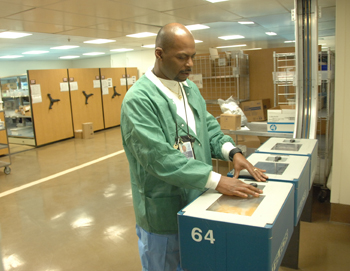 |
| Above, Kerry Bruton sends a box of surgical gloves to a patient unit using the tele-car system. Smaller items travel through the CC's tube system. Such efficiency helps keep the hospital moving. Below, Connie Williams, sterile supply technician, organizes metal instruments for sterilization with heat/steam. Her department, Central Hospital Supply, also manages sterilization of items using low temperature methods such as ethylene oxide gas and vaporized hydrogen peroxide. |
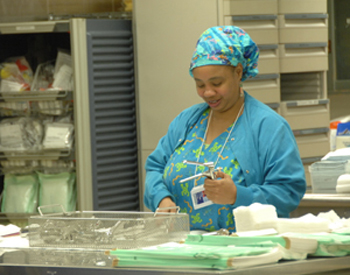 |
Bandages, needles, sterile equipment, and isolation carts are necessary items in any hospital, and the Clinical Center is no different. The group that assures such specialized items are provided to the departments of the CC, which boasts about 7,000 inpatient admissions and 100,000 outpatient visits a year, is Central Hospital Supply (CHS).
"We are the hub of this Clinical Center. The doctors and nurses couldn't do their job without supplies," said medical supply technician Kerry Bruton.
CHS, a division of the Materials Management Department, distributes medical-surgical supplies and biomedical equipment through an established system based on historical consumption and an online response system for immediate or unique demands. An automated station in virtually every patient-care area—inpatient units and day hospitals, outpatient clinics, phlebotomy, Radiology and Imaging Sciences, the Department of Anesthesia and Surgical Services—and in the Department of Laboratory Medicine maintains a standard complement of medical-surgical supplies specific to the needs of each patient-care or service unit.
To use the system, clinical staff log on to the station and press a take or return button on the bin of their selected item. This crucial step links to the CHS inventory to alert staff when they need to replenish the machine's supply. Completing this step rather than simply taking an item or putting one back without registering the action is crucial to help CHS equip the units with what they need.
Larger orders or those for materials not found in the unit's supply station (routine or stat requests) come in through the visual supply catalog, which is constantly monitored. The catalog identifies by description and photograph the more than 3,000 items in the supply inventory. This assures that the requestor is clear on the product needed and the correct product is sent without delay. The next step takes CHS employees to an online inventory database, which reports the desired item's location in one of the two CHS locations (Hatfield and Magnuson buildings).
Another service of CHS is decontamination and sterilization. Metal and plastic reusable instruments are cleaned, sterilized, inspected, assembled, and packaged as needed. Rows of surgery supply carts line the hallways, filled with clean instruments ready to picked up for the day's procedures. CHS also provides technical support on new protocol designs that may include determination of appropriate sterilization methods or the creation of new instrument trays or custom care kits.
"CHS, in a team effort, achieves excellence in customer service by providing safe medical-surgical supplies in a cost-effective and timely manner for clinical care and protocol support," said Paula Wrenn, chief of CHS.
This article is part of a series profiling the many Clinical Center services that contribute to the advancement and enhancement of patient care, research, and training. If you would like your section to be featured in an upcoming issue of CCNews, contact editor Maggie McGuire at 301-594-5789 or mcguirema@cc.nih.gov.
Back to Top
CC pharmacology course expands to China
There is a growing interest in clinical pharmacology worldwide, given that it provides the scientific basis for drug development and drug utilization in therapeutics. China, like other emerging medical communities, is interested in establishing a viable pharmaceutical industry base and in training professionals in the principles of clinical pharmacology and drug development sciences.
In November, the Clinical Center Office of Clinical Research Training and Medical Education was invited by a nonprofit organization, GlobalMD, to present its Principles of Clinical Pharmacology course in Beijing. GlobalMD also welcomed CC Director Dr. John I. Gallin in 2008 and 2009 to China to present the CC’s Introduction to the Principles and Practice of Clinical Research course.
Principles of Clinical Pharmacology faculty members Dr. Juan Lertora, director of CC clinical pharmacology; Dr. Arthur Atkinson, adjunct professor at Northwestern University Feinberg School of Medicine Department of Molecular Pharmacology and former Principles of Clinical Pharmacology course director and textbook editor; and Dr. Diane Mould, president of Projections Research, Inc., taught the course over four day-long sessions, November 16 to 19. Guest faculty Dr. Frank Gonzalez, director of the Drug Metabolism Laboratory at the National Cancer Institute, and Dr. Shiew-Mei Huang, deputy director of the Office of Clinical Pharmacology at the Food and Drug Administration (FDA), also participated. Dr. David Flockhart, a Principles of Clinical Pharmacology faculty member and chief of the Division of Clinical Pharmacology at the Indiana University School of Medicine, also took part in a panel on pharmacogenomics.
"Our Chinese hosts value the leading role of the NIH in biomedical and clinical research and want to adopt similar standards in their country," Lertora said. "Our target audience was made up of physicians, pharmacists, basic and clinical pharmacologists, and other biomedical scientists working in Chinese academic, industrial, and governmental institutions." Host organizations were the 307 Hospital in Beijing and the Chinese Clinical Pharmacology Association.
Clinical pharmacology is a translational discipline in the broad field of clinical research. Once a new molecular entity is discovered and its effects on biological systems are defined in cell systems in vitro (outside the body) and in whole animal experiments, the entity may become a drug candidate. Thus the drug development process starts: pre-clinical (animal) and clinical (human) phases are required to demonstrate that the drug candidate is both safe and effective before the drug is approved by the FDA and is marketed for clinical use. Clinical pharmacologists are involved in the translation of knowledge acquired in the pre-clinical phase to the clinical phase of drug development, as well as in the conduct of early clinical trials—Phase I, for proof of sufficient safety to be given to humans and to define how the drug is handled by the body, and Phase II, for proof of concept in terms of therapeutic efficacy.
While in Beijing, the course faculty were also invited to participate in a special workshop and panel discussion with their Chinese counterparts and members of the Chinese State FDA that considered Chinese clinical pharmacology research and drug trials regulation, as well as the standards promoted by the US FDA and the NIH for the conduct of clinical research and drug development studies.
Learn more about the Principles of Clinical Pharmacology course at http://www.cc.nih.gov/training/training/principles.html.
Back to Top
Doppman lecture presents better visualization of cancer
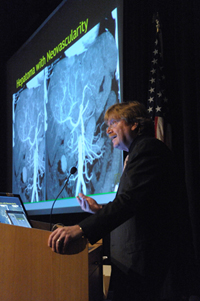 |
Dr. Elliot K. Fishman of The Johns Hopkins Hospital presented advancements in oncologic imaging at the John Doppman Memorial Lecture in December.
|
Dr. Elliot K. Fishman presented the Ninth Annual John Doppman Memorial Lecture on December 16 to an audience that included the wife and former colleagues of the late chief of the Clinical Center’s Diagnostic Radiology Department.
Dr. Richard Chang, chief of the Interventional Radiology Section in CC Radiology and Imaging Sciences, profiled Doppman before the lecture began. Chang mentioned in his mentor’s biography that Doppman sold Good Humor ice cream bars in his youth, included because the former chief had such a great sense of humor and was so well regarded by his staff, Chang said.
Fishman, professor of radiology and oncology at Johns Hopkins University School of Medicine, and director of the Division of Diagnostic Imaging and the Division of Abdominal Imaging and Computed Body Tomography at The Johns Hopkins Hospital, referenced his shared goal of Doppman’s—to improve patient care and patient outcomes—in his lecture "CTA and 3-D Visualization: Its Evolving Role in Oncologic Imaging."
New technologies that offer arterial and venous views of potential malignancies allow for better tracking of transition, texture, and neovascularity of abnormalities, Fishman said. Such advances in imaging, coupled with advances in surgery, are helping patients with borderline resectable masses choose a treatment method that favors the best possible outcome. "I think in radiology, as Dr. Doppman said 30 years ago, opportunities have never been greater. Challenges have never been more difficult, but the future has never been brighter," said Fishman.
Following his speech, Fishman was presented a certificate memorializing the event by CC Radiology and Imaging Sciences director, Dr. David Bluemke.
Back to Top
Exceptional individuals and teams presented CC Director's Awards
The 2009 Clinical Center Director’s Awards recognized 98 employees who embody what is best about the CC family—the ability to work creatively, collaboratively, and effectively in carrying out our mission. "Their efforts inspire all of us to renew our commitment to do our best—not only for our patients, but for each other as colleagues working toward this common goal," said CC Director, Dr. John I. Gallin, at the December 18 ceremony.
Administration
Dr. David Bluemke, director, RIS; Sara Byars, chief, OCPRPL; Lillie Coleman, OAM; Mary Hall, CCMD; Rebekah Geiger, OD; Dr. Christine Grady, acting director, Bioethics; Diane Jenifer, Hospitality Services; Ann Marie Matlock, NPCS; Colleen McGowan, OAM; Patricia Sengstack, DCRI; Maggi Stakem, OD
Nurse Administrative Coordinators (Nursing and Patient Care Services): Courtney Cornell, Rebecca Dove, Chanelle Gutari, Marie-Carole Henry, Maureen O’Bryan, Donna Owolabi, Jane Romero, Anita Segar
Department of Clinical Research Informatics Project Management Office: Susan Houston, Ryan Kennedy, Judy Wight, Nicole White
Jesse Ferguson Customer Service Award
Vicki Chang, OFRM; Maria Guzman, SWD; Mary Haak, OPC; Tiffany Heath, NPCS; Brenda Jimenez, NPCS; Tor Moore, DLM; Mary Ellen Savarese, NIH ORS
Mentoring
Lynda Ray, OAM
Patient Care
Kathleen Castro, NPCS; Gerard Jacobs, PET; Shelia Richardson, NPCS; Beverly Smith, NPCS; James Vucich, RIS
Science
Dr. Yuen-Yi "Christine" Hon, Pharmacy; Dr. Elizabeth Rasch, RMD; Nancy Sebring, Nutrition; Dr. Shuibang Wang, CCMD
Strategic Initiatives
Raymond Bowen, OFM; Dr. James Cimino, chief, LID; David Folio, chief, Nutrition; John Kocher, DCRI
Bar Coding Initiative Team: Cheryl Clarke, DLM; Elizabeth McNamara, LID
Critical Care Medicine Team: Carolea Logun, Melanie Reagan, Dr. Steven Solomon
Data Transformation Initiative Team: Erin Dominick, OFRM; Chris Epinger, OFRM; Dr. Srini Iyer, OMAR; Dr. Jon McKeeby, chief information officer, DCRI; Melissa Moore, OMAR; Joe Pardi, OFRM; James Pitts, DCRI; Daniel Rinehuls, OFRM; Rachel Schacherer, OD
Omnicell Implementation Team: Dr. Michael Brown, Pharmacy; Jason Chan, DCRI; Janice Davis, NPCS; Thomas Dorworth, Pharmacy; Justine Harris, Pharmacy; Dr. Chau Hoang, Pharmacy; Peter Matias, Pharmacy; Jharana Patel, Pharmacy; Anuradha Pendlimarri, Pharmacy; Isolina Rivera, DCRI; James Schlick, Pharmacy; David Vinh, DCRI; Christine Yoon, Pharmacy; Dr. Jessica Weintraub, Pharmacy
Office of Purchasing and Contracts Small Business Outreach Team: Janice Brunson, Malinda Dehner, Maryel Herzog, Susan Huddleston, Jearnean Jackson, Henry Primas, Joe Tewes, Dianna Snowden-Robinson
Rehabilitation Medicine Data Transformation-Activity Management Team: Diane Brandt, Willie Ching, Bonnie Hodsdon, Donna Gregory, Dr. Galen Joe, Marcia Smith, Michaele Smith, Beth Solomon, Lucy Swan
Teaching/Training
Dr. Cheryl Fisher, NPCS; Dr. Robert Lembo, OCRTME; Dr. Sandra Mitchell, NPCS; Emmanuel Samedi, NPCS; Dr. David Wendler, Bioethics
Quality of Worklife/Diversity
Esther Wolfrey, RIS
Special Recognition
William Cullen, NIH ORS; Antoinette Royster, Patient Advisory Group; Daniel Wheeland, NIH ORS
Back to Top
Kermit and the gang earn 3SE-N first place in gingerbread contest
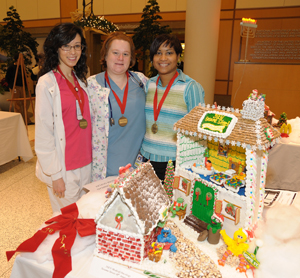 |
From left, Amy Stewart, Laura Kannaian, and Yvonne Wall were on the 3SE-N team that created the winning 2009 gingerbread house.
|
Note to future gingerbread contest entries: pop culture references are a crowd pleaser. Two of the top three immortalized recognizable locations—Sesame Street and McDonald's—in fondant and candies for the sixth annual contest, which pulled 28 submissions made by various Clinical Center departments and more than 2,500 votes.
Organized by Ann Marie Matlock of Nursing and Patient Care Services (NPCS), the contest displayed the entries in the CC atrium for a month through the holidays, inviting passersby to vote between December 4 and 17 on their pick for most creative and best executed. Dr. David Henderson, deputy director of clinical care, announced the results on December 18.
Laura Kannaian, a member of the winning 3SE-N team, said of their Sesame Street-themed work of art, "There are a lot of man hours in this. It was a total floor effort." Second place went to the 3SW-N steamboat recreation, and completing the third floor sweep was 3NE's McDonald's gingerbread "house."
Partnered with the contest was a food drive to benefit The Children's Inn. Cynthia Herringa, nursing recruitment consultant in NPCS, has coordinated the drive for the last four years and was pleased with the 2009 turnout. "Everyone was very generous this year," she said.
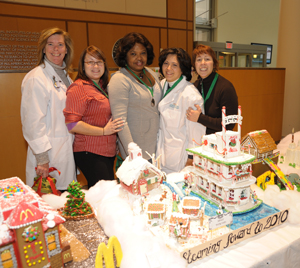 |
Second place team from 3SW-N included (from left) Deborah Gutierrez, Bethzaida Matos, Caroline Samedy, Linda Tondreau, and Kinneret Broder.
|
|
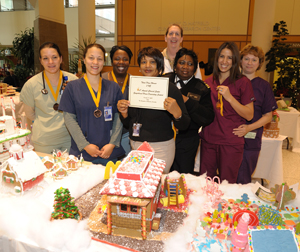 |
The 3NE team that took third place included (from left) Jennifer Gatt, Nicole Ritzau, Shawna Oliver-Wilder, Phyllis Vincent, Diane Aker, Beverly Smith, Rebecca Badu, and Galine Malysheza. Susan Perry, Rasheda Persinger, Brenna Hansen and Celine Gogoua also contributed.
|
|
Back to Top
Clinical research trainees share a different talent with CC patients
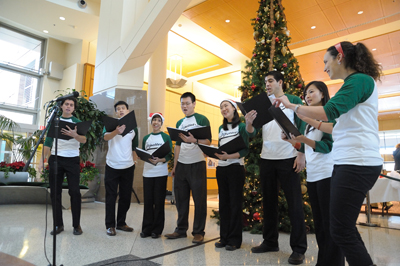 |
|
The Pipettes, an a capella group of NIH and HHMI trainees, performed in the CC atrium in December. From left are Dan King, Robert Huang, Ambereen Kurwa, Alan Zhou, So Yeon Paek, Horacio Duarte, Anne Zhuang, and Emily Maxson. Member Vishnu Kannabiran is not pictured. "It can get really busy in medical school, so it is great to have the opportunity to rediscover music," said Zhuang.
|
In addition to sharing a passion for science and research, a group of medical students participating in year-long mentored research programs at the NIH also share a love for music. These nine, affiliated with either the NIH Clinical Research Training Program (CRTP) or the Howard Hughes Medical Institute (HHMI)-NIH Research Scholars Program, formed the a capella singing group The Pipettes and have performed at various events around the Clinical Center, most recently in the atrium on December 17.
"It's great to connect with patients on a different level then we normally do," said CRTP fellow Ambereen Kurwa.
The group is comprised of musicians with various backgrounds and manages to rehearse twice a week—once as a large group and once as smaller groups working on individual parts.
Dr. Frederick Ognibene, deputy director of clinical research training and strategic partnerships, introduced The Pipettes at their December concert to CC staff, patients, and visitors. "When they aren't singing together, they are conducting research across the NIH campus," he said. "Today, they hope to share some of their musical joy with the NIH community that has so warmly welcomed them."
The group plans to schedule another performance sometime in the spring for the CC patients.
Back to Top
CFC drawing raises $10K for charities
Gina Ford goes in for a celebratory hug with Clinical Center director Dr. John I. Gallin after winning the CC Combined Federal Campaign (CFC) Basket Drawing's Stay-cation
Basket. Behind them, the CC CFC coordinators cheer on their coworker.
Ford, nurse consultant to the CC's deputy director of clinical care, took home two-night stays at The Ritz-Carlton in Washington, DC, and the Doubletree Hotel in Bethesda and a $100 American Express gift card.
The CFC Basket Drawing offered a chance to win one of 20 themed baskets, contents donated by various CC departments. Tickets were sold over four days, and the drawing was held December 3. This year's drawing raised $10,538 in ticket sales, with all proceeds donated to CFC charities.
Back to Top
News Briefs
Medical arts drops hourly labor rate by more than 25 percent
In a continued effort to meet the needs of the NIH community, Medical Arts now offers a $91 hourly labor rate (previously $125) for medical illustration, express services, design illustration, photomic and photomac services.
This reduction in rate affects the cost of design of posters, brochures, publications, and other materials; medical animation or illustration; and close-up and microscopic photography.
Medical Arts has served the NIH community for more than 80 years as part of the Office of Research Services. For more information on the new rates or any of the Medical Arts services, visit http://medarts.nih.gov.
A green idea from the Clinical Center Green Team
The Clinical Center is committed to using natural resources responsibly and that includes our use of energy. The NIH Bethesda campus is the largest user of energy in Montgomery County, spending more than $65.5 million on electricity every year. Approximately 10 percent of that is used by the CC, amounting to about $6.5 million worth of electricity.
How can you help get that number down? Contribute to the CC's commitment to environmental stewardship by turning off any unnecessary lights. If you are leaving a room for more than five minutes, flip the switch to help save the earth.
Santa makes a stop at the Clinical Center
The Rehabilitation Medicine Department Recreation Therapy Section hosted a special guest on December 15. Santa Claus made an appearance in the Clinical Center Main Playroom, and to get ready for their time with the jolly old soul, pediatric patients first made a wish list with Recreation Therapy staff and medical student volunteers. Also there to entertain: The Pipettes, an a cappella group of NIH and Howard Hughes Medical Institute trainees. Right, art therapist Megan Robb (far right) and Radiology and Imaging Sciences fellow Hilary Hancock, a Recreation Therapy Section volunteer, work with (from left) Rudi Belen, Benjamin Lopez, and Maggie Cobb on their letters to Santa.
NCRR forum promotes work with academia and industry
The Clinical and Translational Science Award (CTSA) Industry Forum: Promoting Efficient and Effective Collaborations among Academia, Government and Industry on February 17 and 18, hosted by the National Center for Research Resources, will explore ways to streamline the development of new drugs, devices, and diagnostics.
Both days will begin at 8:00 am in the Natcher Conference Center (Building 45), and the event is free and open to the public.
NIH Director Dr. Francis Collins will present "Why Industry and Academia Should Work Together: An NIH Perspective." Other speakers from academia, government, nonprofit, venture capital, and industry will discuss translational research topics including opportunities and unmet needs; issues and barriers to drug, diagnostic, and device development; international efforts; and educational curriculum.
Poster topic areas will focus on two key areas:
- translational research collaboration among academia, industry, nonprofit organizations, or government to comercialize items such as new therapeutics, devices, and diagnostics to improve public health, and
- prior successful models or new proposed models for translational research collaboration among academia, industry, nonprofit organizations, or government.
Posters are due by February 1; registration closes on February 5. To register or to submit a poster, visit www.palladianpartners.com/CTSAIndustryForum [disclaimer].
Back to Top
January 6, 2010
CC Grand Rounds
Lipsett Amphitheater, 12 noon
Human Subjects Research and the Internet Era
Robert Martensen, MD, PhD
Director, Office of History and Museum, NIH
Updates on Therapies for Hairy Cell Leukemia
Robert Kreitman, MD
Chief, Clinical Immunotherapy Section, Laboratory of Molecular Biology, NCI
Wednesday Afternoon
Lecture Series
Masur Auditorium, 3 pm
Wrong Place, Wrong Time: Understanding Trauma and Violence in the Lives of Young Black Men
John Rich, MD, MPH
Professor and Chair, Department of Health Management and Policy
Director, Center for Nonviolence and Social Justice
Director, Center for Academic Public Health Practice
Drexel University
January 13, 2010
CC Grand Rounds
Lipsett Amphitheater, 12 noon
Contemporary Clinical Medicine: Great Teachers
Treating Chronic Hepatitis B and C
Jenny Heathcote, MBBS, MD
Professor of Medicine and Francis Family Chair in Hepatology, University of Toronto
Division Head, Patient Based Clinical Research, Toronto Western Research Institute
Wednesday Afternoon
Lecture Series
Masur Auditorium, 3 pm
Protein Folding: Seeing is Deceiving
George Rose, PhD
Krieger-Eisenhower Professor of Biophysics, Johns Hopkins University
January 20, 2010
CC Grand Rounds
Lipsett Amphitheater, 12 noon
Updates in Obesity Research
Giovanni Cizza, MD, PhD, Sc
Tenure-Track Investigator, Clinical Endocrinology Branch, Division of Intramural Research, NIDDK
Measuring Energy Expenditure in Humans: Tales from the Metabolic Chamber
Kong Chen, PhD, MSCI
Director, Metabolic Research Core, Division of Intramural Research
Tenure-Track Investigator, Clinical Endocrinology Branch, Division of Intramural Research, NIDDK
January 27, 2010
CC Grand Rounds
Lipsett Amphitheater, 12 noon
Ciliary Diseases: Converging Observations and Diverging Models
Meral Gunay-Aygun, MD
Staff Clinician, Medical Genetics Branch, NHGRI
Gregory G. Germino, MD
Deputy Director, NIDDK
Wednesday Afternoon
Lecture Series
Masur Auditorium, 3 pm
Molecular Chaperones in Protein Folding and Neurodegeneration
Arthur Horwich, MD
Sterling Professor of Genetics, Yale School of Medicine
HHMI Investigator
Back to Top
This page last updated on 12/14/2017


 The information on this page is archived and provided for reference purposes only.
The information on this page is archived and provided for reference purposes only.